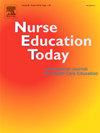跨专业团队训练中虚拟现实与高保真仿真的混合方法研究
IF 4.2
2区 医学
Q1 EDUCATION, SCIENTIFIC DISCIPLINES
引用次数: 0
摘要
在注册前水平发展跨专业能力对于准备一支致力于以患者为中心的护理和安全的协作实践就绪的劳动力至关重要。目的(1)评估混合学习方法与基于模拟的TeamSTEPPS®(BLAST)培训对护理和医学生在跨专业合作中的态度、知识和感知信心的影响;(2)探索学生的学习经验和模拟辅导员的教学经验。设计混合方法设计使用一组前测后测设计和焦点小组讨论。新加坡一所公立高等教育大学。方法护理和医学生参加BLAST培训,该培训采用多用户虚拟现实模拟和高保真模拟进行TeamSTEPPS®培训。前后测试评估了学生对TeamSTEPPS®关键概念和工具的理解,以及他们对跨专业团队合作的态度和信心。与学生和模拟主持人进行了九次焦点小组讨论。定量和定性数据进行三角测量。结果学生在对TeamSTEPPS®关键概念的理解、对跨专业团队合作的总体态度和跨专业培训的感知价值方面表现出统计学上的显著改善。通过虚拟现实仿真,提高学生参与高保真仿真的信心。焦点小组讨论中出现了三个主题:(1)跨专业学习的协同作用,(2)混合模拟作为学习支架,(3)混合模拟的操作化。三角数据显示,将虚拟现实模拟与现场模拟相结合是一种很有前途的跨专业培训教学方法。结论:本研究支持使用基于混合模拟的学习方法进行跨专业团队培训,突出了架式学习在增强护理和医学生之间的知识、协作和沟通技能方面的好处。研究结果表明,需要创新的方法来实现可持续和可扩展的跨专业团队培训。本文章由计算机程序翻译,如有差异,请以英文原文为准。
Blending of virtual reality with high-fidelity simulation for interprofessional team training: A mixed methods study
Background
Developing interprofessional competencies at the pre-registration level is essential for preparing a collaborative practice-ready workforce committed to patient-centered care and safety.
Aim
(1) To evaluate the impact of a Blended Learning Approach with Simulation-based TeamSTEPPS® (BLAST) training on nursing and medical students' attitudes, knowledge, and perceived confidence in interprofessional collaboration, and (2) to explore the learning experiences of students and teaching experiences of simulation facilitators.
Design
Mixed-methods design using a one-group pretest-posttest design and focus group discussions.
Setting
A public tertiary university in Singapore.
Methods
Final year nursing and medical students participated in the BLAST training, which delivered the TeamSTEPPS® training using multi-user virtual reality simulation followed by high-fidelity simulation. Pre- and post-tests assessed students' understanding of TeamSTEPPS® key concepts and tools, as well as their attitudes and perceived confidence in interprofessional teamwork. Nine focus group discussions were conducted with students and simulation facilitators. Quantitative and qualitative data were triangulated.
Results
Students demonstrated statistically significant improvements in their understanding of TeamSTEPPS® key concepts, overall attitudes towards interprofessional teamwork, and perceived value of interprofessional training. The virtual reality simulation was reported to improve students' confidence in participating the high-fidelity simulation. Three themes emerged from the focus group discussions: (1) synergy of interprofessional learning, (2) blended simulation as a learning scaffold, and (3) operationalizing blended simulation. The triangulated data revealed that the integration of virtual reality simulation followed by in-person simulation was a promising pedagogical approach for interprofessional training.
Conclusion
This study supports the use of a blended simulation-based learning approach for interprofessional team training, highlighting the benefits of scaffolded learning in enhancing knowledge, collaboration, and communication skills among nursing and medical students. The findings point to the need for innovative approaches to enable sustainable and scalable interprofessional team training.
求助全文
通过发布文献求助,成功后即可免费获取论文全文。
去求助
来源期刊

Nurse Education Today
医学-护理
CiteScore
6.90
自引率
12.80%
发文量
349
审稿时长
58 days
期刊介绍:
Nurse Education Today is the leading international journal providing a forum for the publication of high quality original research, review and debate in the discussion of nursing, midwifery and interprofessional health care education, publishing papers which contribute to the advancement of educational theory and pedagogy that support the evidence-based practice for educationalists worldwide. The journal stimulates and values critical scholarly debate on issues that have strategic relevance for leaders of health care education.
The journal publishes the highest quality scholarly contributions reflecting the diversity of people, health and education systems worldwide, by publishing research that employs rigorous methodology as well as by publishing papers that highlight the theoretical underpinnings of education and systems globally. The journal will publish papers that show depth, rigour, originality and high standards of presentation, in particular, work that is original, analytical and constructively critical of both previous work and current initiatives.
Authors are invited to submit original research, systematic and scholarly reviews, and critical papers which will stimulate debate on research, policy, theory or philosophy of nursing and related health care education, and which will meet and develop the journal''s high academic and ethical standards.
 求助内容:
求助内容: 应助结果提醒方式:
应助结果提醒方式:


